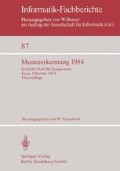Abstract
A relational description is a set of relations that can be used to represent an object model or to describe the features, properties, and interrelationships extracted from an image. Given two such relational descriptions, the relational distance between them tells us how similar are two models (for grouping purposes) or how well a part of an image matches a particular model (for identification purposes). Furthermore, once two descriptions have been judged similar enough by their relational distance, the mapping derived from the matching process can be used to determine symbolic differences between them that may aid in the process of image analysis. In this paper we will define all of the above concepts and then discuss some matching procedures — both in general and for some specific matching problems we are encountering in an industrial inspection task. We will also discuss the complex models being used for this task and the problem of organizing object models in general.
Access this chapter
Tax calculation will be finalised at checkout
Purchases are for personal use only
Preview
Unable to display preview. Download preview PDF.
References
Barrow, Ambler, and Burstall, “Some Techniques for Recognizing Structures in Pictures”, in Frontiers of Pattern Recognition, Ed. S. Watanabe, New York, Academic Press, 1972, pp. 1–29.
Brooks, R.A., “Symbolic Reasoning Among Three-Dimensional Models and Two-Dimensional Images”, Artificial Intelligence, Special Vol. on Computer Vision, AI 17, 1981.
Cheng, J.K. and T.S. Huang, “Image Recognition by Matching Relational Structures”, Proceedings of IEEE Pattern Recognition and Image Processing, 1981, pp. 542–547.
Davis, L.S., “Shape Matching Using Relaxation Techniques”, IEEE Transactions on Pattern Analysis and Machine Intelligence, Vol. PAMI-1, No. 1, January 1979, pp. 60–72.
Feustel, C.D. and L.G. Shapiro, “The Nearest Neighbor Problem in an Abstract Metric Space”, Pattern Recognition Letters, Vol. 1, No. 2, December 1982, pp. 125–128.
Freuder, E.C. , “Synthesizing Constraint Expression”, CACM, Vol. 21, No. 11, 1978.
Gaschnig, J., “A General Backtrack Algorithm that Eliminates Most Redundant Tests”, Proceedings of the 5th International Joint Conference on Artificial Intelligence, 1972.
Haralick, R.M. and G. Elliot, “Increasing Tree Search Efficiency for Constraint Satisfaction Problems”, Proceeding of the 6th International Joint Conference on Artificial Intelligence, 1979.
Haralick, R.M. and L.G. Shapiro, “The Consistent Labeling Problem: Part I”, IEEE Transactions on Pattern Analysis and Machine Intelligence, Vol. PAMI-1, No. 2, April 1979, pp. 173–184.
Mackworth, A. , “Consistency in Network of Relations”, Artificial Intelligence, Vol. 8, 1977, pp. 99–118.
Marr, D. and H.K. Nishihara, Spatial Disposition of Axes in a Generalized Cylinder Representation of Objects that do not Encompass the Viewer, MIT AI Lab, Memo. No. 341, December 1975.
Montanari, U., “Networks of Constraints: Fundamental Properties and Applications to Picture Processing”, Information Sciences, Vol. 7, 1974, pp. 95–132.
Mulgaonkar, P.G., Shapiro, L.G. and R.M. Haralick, Identification of Man-Made Objects Using Geometric and Relational Constraints, Virginia Polytechnic Institute, Department of Computer Science, September 1982.
Nevatia, R. and T.O. Binford, “Description and Recognition of Curved Objects”, Artificial Intelligence, 8, 1977, pp. 77–90.
Rosenfeld, A., Hummel, R.A. and S.W. Zucker, “Scene Labeling by Relaxation Operations”, IEEE Transactions on Systems, Man, and Cybernetics, Vol CMS-6, No. 6, June 1976, pp. 420–433.
Sanfelieu, Alberto and K.S. Fu, “A Distance Measure Between Attributed Relational Graphs for Pattern Recognition”, IEEE Transactions on Systems, Man and Cybernetics, Vol. SMC-13, No. 3, May/June 1983.
Schneier, M., “A Compact Relational Structure Representation”, in Workshop on the Representation of Three-Dimensional Objects, R. Bajcy, Director, University of Pennsylvania, Philadelphia, May 1–2, 1979.
Shapiro, L.G., J.D. Moriarty, P.G. Mulgaonkar, and R. M. Haralick, “A Generalized Blob Model for Three-Dimensional Object Representation”, IEEE Workshop on Picture Data Description and Management, Asilomar, CA, August 1980.
Shapiro, L.G., “A Structural Model of Shape”, IEEE Transactions on Pattern Analysis and Machine Intelligence, Vol. PAMI-2, No. 2, March 1980, pp. 111–126.
Shapiro, L.G. and R.M. Haralick, “Structural Descriptions and Inexact Matching”, to appear in IEEE Transactions on Pattern Analysis and Machine Intelligence, 1981.
Shapiro, L.G., J.D. Moriarty, R.M. Haralick, and P.G. Mulgaonkar, Matching Three-Dimensional Objects Using a Relational Paradigm, TR-CS80014R, Department of Computer Science, Virginia Polytechnic Institute and State University, December 1980, Revised January 1983.
Shapiro, L.G. and R.M. Haralick, “Organization of Relational Models for Scene Analysis”, IEEE Transactions on Pattern Analysis and Machine Intelligence, Vol. PAMI-4, No. 6, November 1982.
Shapiro, L.G. and R.M. Haralick, “Decomposition of TwoDimensional Shapes by Graph-Theoretic Clustering”, IEEE Transactions on Pattern Analysis and Machine Intelligence, PAMI-1, No. 1, 1979.
Shapiro, L.G. and R.M. Haralick, “A Hierarchical Relational Model for Automated Inspection Tasks”, Proceedings of the International Conference on Robotics, Atlanta, 1984, pp. 70–77.
Ullman, J.R., “An Algorithm for Subgraph Homomorphisms”, JACM, Vol. 23, January 1976, pp. 31–42.
Waltz, D., “Understanding Line Drawings of Scenes with Shadows”, in The Psychology of Computer Vision, ed. P. Winston, McGraw-Hill, New York, 1975, pp. 19–91.
Author information
Authors and Affiliations
Editor information
Editors and Affiliations
Rights and permissions
Copyright information
© 1984 Springer-Verlag Berlin Heidelberg
About this paper
Cite this paper
Shapiro, L.G. (1984). Relational Matching — Problems, Techniques, and Applications. In: Kropatsch, W. (eds) Mustererkennung 1984. Informatik-Fachberichte, vol 87. Springer, Berlin, Heidelberg. https://doi.org/10.1007/978-3-662-02390-7_4
Download citation
DOI: https://doi.org/10.1007/978-3-662-02390-7_4
Publisher Name: Springer, Berlin, Heidelberg
Print ISBN: 978-3-540-13859-4
Online ISBN: 978-3-662-02390-7
eBook Packages: Springer Book Archive

